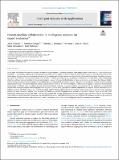Files in this item
Human-machine collaboration in intelligence analysis : an expert evaluation
Item metadata
| dc.contributor.author | Toniolo, Alice | |
| dc.contributor.author | Cerutti, Federico | |
| dc.contributor.author | Norman, Timothy J. | |
| dc.contributor.author | Oren, Nir | |
| dc.contributor.author | Allen, John A. | |
| dc.contributor.author | Srivastava, Mani | |
| dc.contributor.author | Sullivan, Paul | |
| dc.date.accessioned | 2022-12-09T12:30:06Z | |
| dc.date.available | 2022-12-09T12:30:06Z | |
| dc.date.issued | 2023-02-01 | |
| dc.identifier | 282155882 | |
| dc.identifier | 71dfe1b7-48ab-4284-98b9-14b7536e8235 | |
| dc.identifier | 85145654115 | |
| dc.identifier.citation | Toniolo , A , Cerutti , F , Norman , T J , Oren , N , Allen , J A , Srivastava , M & Sullivan , P 2023 , ' Human-machine collaboration in intelligence analysis : an expert evaluation ' , Intelligent Systems with Applications , vol. 17 , 200151 . https://doi.org/10.1016/j.iswa.2022.200151 | en |
| dc.identifier.issn | 2667-3053 | |
| dc.identifier.other | RIS: urn:B33F45806A7697661B3279C0383C37E9 | |
| dc.identifier.other | ORCID: /0000-0002-6816-6360/work/124489982 | |
| dc.identifier.uri | https://hdl.handle.net/10023/26566 | |
| dc.description | Funding: This research was sponsored by the U.S. Army Research Laboratory and the U.K. Ministry of Defence and was accomplished under Agreement Number W911NF-06-3-0001. | en |
| dc.description.abstract | In this paper we illustrate how novel AI methods can improve the performance of intelligence analysts. These analysts aim to make sense of — often conflicting or incomplete — information, weighing up competing hypotheses which serve to explain an observed situation. Analysts have access to numerous visual analytic tools which support the temporal and/or conceptual structuring of information and collection, and support the evaluation of alternative hypotheses. We believe, however, that there are currently no tools or methods which allow analysts to combine the recording and interpretation of information, and that there is little understanding about how software tools can facilitate the hypothesis formation process. Following the identification of these requirements, we developed the CISpaces (Collaborative Intelligence Spaces) decision support tool in collaboration with professional intelligence analysts. CISpaces combines multiple AI-based methods including argumentation theory, crowdsourced Bayesian analysis, and provenance recording. We show that CISpaces is able to provide support to analysts by facilitating the interpretation of different types of evidence through argumentation-based reasoning, provenance analysis and crowdsourcing. We undertook an experimental analysis with intelligence analysts which highlights three key points. (1) The novel, principled AI methods implemented in CISpaces advance performance in intelligence analysis. (2) While designed as a research prototype (at TRL 3), analysts benchmarked it against their existing software tools, and we provide results suggesting intention to adopt CISpaces in analysts’ daily activities. (3) Finally, the evaluation highlights some drawbacks in CISpaces. However, these are not due to the technologies underpinning the tool, but rather its lack of integration with existing organisational standards regarding input and output formats. Our evaluation with intelligence analysts therefore demonstrates the potential impact that an integrated tool building on state-of-the-art AI techniques can have on the process of understanding complex situations, and on how such a tool can help focus human effort on identifying more credible interpretations of evidence. | |
| dc.format.extent | 35 | |
| dc.format.extent | 4783434 | |
| dc.language.iso | eng | |
| dc.relation.ispartof | Intelligent Systems with Applications | en |
| dc.subject | QA75 Electronic computers. Computer science | en |
| dc.subject | T-NDAS | en |
| dc.subject | MCC | en |
| dc.subject.lcc | QA75 | en |
| dc.title | Human-machine collaboration in intelligence analysis : an expert evaluation | en |
| dc.type | Journal article | en |
| dc.contributor.institution | University of St Andrews. School of Computer Science | en |
| dc.identifier.doi | https://doi.org/10.1016/j.iswa.2022.200151 | |
| dc.description.status | Peer reviewed | en |
This item appears in the following Collection(s)
Items in the St Andrews Research Repository are protected by copyright, with all rights reserved, unless otherwise indicated.

